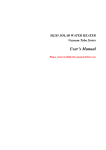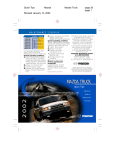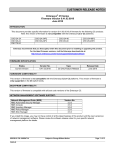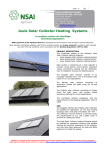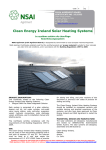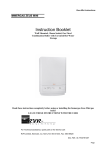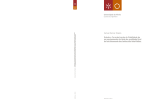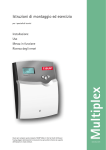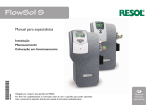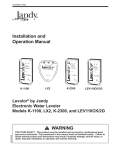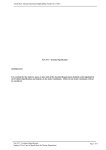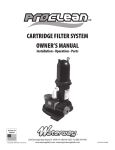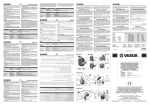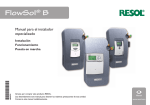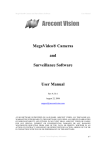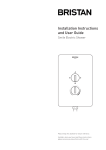Download RVR Solar Heating Systems
Transcript
CI/SfB 41 Rq2 IRISH AGRÉMENT BOARD CERTIFICATE NO. 12/0372 RVR Energy Technology Ltd. Gortamullen, Kenmare, Co. Kerry . T: 064 6641344 F: 064 6689520 E: [email protected] W: www.rvr.ie RVR Solar Heating Systems Le système solaire de chauffage Solarheizungssystem NSAI Agrément (Irish Agrément Board) is designated by Government to issue European Technical Approvals. NSAI Agrément Certificates establish proof that the certified products are ‘proper materials’ suitable for their intended use under Irish site conditions, and in accordance with the Building Regulations 1997 to 2012. USE: The RVR Solar Heating Systems can be used in new and existing buildings with a roof pitch of between 25o and 70o. The collector must be fixed to a roof that meets the requirements of I.S. ICP 2:2002 Code of practice for slating and tiling, and prior versions of this document or previous Irish codes of practice for slating and tiling. In addition, all aspects of the Solar Heating System shall be designed and installed to comply with SR 50-2:2011 Code of practice for building services – Part 2: Solar panels (to be published). PRODUCT DESCRIPTION: This Certificate relates to RVR Solar HP collectors and auxiliary system components. The system is comprised of an RVR Solar HP collector, a cylinder, pump station, control panel, expansion vessel, connections, sloping roof kit, antifreeze, user & installation instructions and labelling packs. The RVR Solar HP Collector consists of an insulated manifold and a row of evacuated solar tubes incorporating a Heat Pipe technology for on-roof applications. The RVR Solar Heating Systems should be installed by competent persons with suitable training (including system specific training by the Certificate holder) and practical experience of the systems, and who have been approved by RVR Energy Technology Ltd and NSAI Agrément to install the system. MARKETING, DESIGN AND MANUFACTURE: The RVR Solar HP collectors are designed, manufactured and tested by Jiangsu Sunrain Solar Energy Co. Ltd. China. The solar kits are designed and distributed by: RVR Energy Technology Ltd. Gortamullen, Kenmare, Co. Kerry . T: 064 6641344 F: 064 6689520 E: [email protected] W: www.rvr.ie Readers are advised to check that this Certificate has not been withdrawn or superseded by a later issue by contacting NSAI Agrément, NSAI, Santry, Dublin 9 or online at http://www.nsai.ie/modules/certificates/uploads/pdf/IAB120372.pdf Part One / Certification 1.1 ASSESSMENT In the opinion of NSAI Agrément, the RVR Solar Heating Systems, if used in accordance with this Certificate can meet the requirements of the Building Regulations 1997 to 2012, as indicated in Section 1.2 of this Agrément Certificate. 1.2 BUILDING REGULATIONS 1997 to 2012 REQUIREMENTS: Part D – Materials and Workmanship D3 – Proper Materials The RVR Solar Heating Systems, as certified in this Certificate, are comprised of ‘proper materials’ fit for their intended use (see Part 4 of this Certificate). D1 – Materials & Workmanship The RVR Solar Heating Systems, as certified in this Certificate, meet the requirements for workmanship. Part A - Structure A1 – Loading The RVR Solar Heating Systems, once appropriately designed and installed in accordance with this Certificate, have adequate strength and stability to meet the requirements of this Regulation (see Part 3 of this Certificate). Part B – Fire Safety B4 – External Fire Spread The RVR Solar Heating Systems will not affect the external fire rating of the roof structure on which they are installed (see Part 4 of this Certificate). Part C – Site Preparation and Resistance to Moisture C4 – Resistance to Weather and Ground Moisture The RVR Solar Heating Systems, once appropriately designed and installed in accordance with this Certificate, will not affect a roof’s resistance to the ingress of moisture (see Part 4 of this Certificate). Part L – Conservation of Fuel and Energy L1 – Conservation of Fuel and Energy The RVR Solar Heating Systems can be designed to meet the minimum level of energy provision from renewable technologies stated in this Regulation (for domestic dwellings), i.e. 10kWh/m2/annum contributing to energy use for domestic hot water heating. Certificate No. 12/0372 / RVR Solar HP Heating Systems 1 Part Two / Technical Specification and Control Data 2.1 PRODUCT DESCRIPTION This Certificate relates to RVR Solar HP collectors and auxiliary system components. The RVR Solar HP collector has been tested to EN 12975-2:2006 Thermal solar systems and components – Solar collectors – Test methods 2 Sunrain Solar Energy Co. Ltd. operate a 100% inspection of their products which include vacuum and stress testing of the evacuated tubes and pressure testing of the copper HP tubes and manifolds 2.1.1 RVR Solar Heat Pipe Solar Collector The RVR Solar HP range of Collectors consists of an array of evacuated ‘Sydney Tubes’ which house the heat pipes and absorbers. Evaporator fluid is contained within the heat pipe. The energy absorbed by the absorber causes the fluid to change from a fluid state to a vapour state and the vapour rises to the condenser bulb. The solar collector mounting frame is manufactured using profiled aluminium vertical and horizontal sections. The manifold is made from pressed aluminium. The header is insulated using polyurethane (PU) foam. The heat pipe condenser (bulb) 24mm diameter x 90mm length is nickel coated to prevent “welding” of heat pipe and heat pipe socket during high temperatures operation. The condenser is connected directly into the manifold via a dry pocket. Within the manifold, the solar system solution is passed across the dry pocket that houses the condenser. The condenser releases the latent heat of evaporation to the solar system solution and condenses. The condensate returns to the heat pipe and the cycle is repeated. 2.3 DELIVERY, STORAGE AND HANDLING RVR supply a full package for each solar heating system installation, which includes the collectors, cylinder, pump station, expansion vessel, connections, antifreeze, stainless steel pipework, connections, solar inhibitor – antifreeze, roof mounting kit, control panel, user & installation manual and labelling packs. Due to the dry connection, RVR Solar HP tubes can be replaced without the need of draining down the solar system. Up to a maximum of 3 x 30 tube collectors can be joined together in series with a flow rate of 5 litres/minute. The following guidelines should be followed when transporting and storing solar system components: • Solar collectors should always be stored indoors. • RVR Solar HP Collector Heat Pipe Tubes should remain in their respective boxes in an upright position during transport and storage. • Cylinders should be transported and stored vertically. • All other solar system components should be stored in a clean, dry, frost free environment until ready for installation. • Heavy goods should never be loaded on top of solar collectors or kit boxes. Figure 1:RVR Solar Heat Pipe Solar Collector 2.2 MANUFACTURE The RVR Solar HP range of Collectors are manufactured by Jiangsu Sunrain Solar Energy Co. Ltd. in China. The management systems of Sunrain have been assessed and registered as meeting the requirements of ISO9001:2000. Under conditions set out by the Solar Keymark Certification, Sunrain Solar Energy are registered and continuously monitored by Fraunhofer ISE, Germany. Manufacture consists of fabrication and assembly of the heat pipes, absorbers, manifolds and evacuated tubes. Parts should be inspected for damage on arrival to site and any damages or losses should be reported to the Certificate holder. Care should be taken when opening kits to prevent scratches or sudden shocks to the collectors and sharp objects should not be used to open the packaging. Certificate No. 12/0372 / RVR Solar Heating Systems 2.4 INSTALLATION 2.4.1 General The RVR Solar Collector Heating Systems should be installed by competent persons with suitable training and practical experience of the systems (including system specific training by the Certificate holder), who have been approved by RVR and NSAI Agrément for this purpose. The installer shall fully understand the requirements of the customer and have completed a user and installation health & safety risk assessment. The necessary plumbing work should be undertaken by a qualified plumber and the necessary electrical work required to install the control equipment, should be undertaken by a qualified RECI electrical contractor. Solar panel installations must be performed in accordance with all Health & Safety legislation and local building/planning regulations. The solar collector must not be left exposed to solar radiation prior to filling or when the solar loop and manifold have been drained. Collectors left exposed in a dry state must be covered to prevent possible long term damage. The solar collector system should be commissioned in low light, or by covering the collector array, until it has cooled down to a safe working temperature; ideally in the morning when the solar loop should be coolest. Fixings used with the RVR Solar collectors, must comply with Clause 4.11 and 5.9 of I.S. ICP 2:2002 and SR 50-2:2011 Code of practice for building services – Part 2: Solar panels (to be published).All tiles adjacent to the collectors should be mechanically fixed in place. Flashings used with the systems must comply with Clause 4.12 of I.S. ICP 2:2002. In high wind load areas, identified during the initial assessment survey, the truss design should be checked by a Structural Engineer for suitability, in relation to the applicable point loads. Any resulting modification required shall form part of the Structural Design report and sign-off documentation issued by the Structural Engineer. This should be completed prior to commencement of work. 2.4.2 Pre-Installation Sizing of the Solar Heating System Minimising the risk of stagnation must be considered by the installer when sizing a solar heating system. The system must not be oversized, but must comply with the requirements of Part L of the Building Regulations 1997 to 2012. The following steps should be taken to correctly size a solar heating system: • Determine the daily hot water demand. • Calculate the hot water heat requirement. • Calculate the storage volume. • Size the required collector area. • Size the system components. Sizing of Safety Equipment Component sizes are relative to the volume of liquid in the system and the RVR Solar Technical Information and Installation Instructions should be consulted for each system. Risk Assessment Before work commences on the installation, a risk assessment must be completed and recorded by the installer. Items assessed include: • Access to roof. • Ability of roof structure to accommodate all applied loadings. • Working at height. • Effects of wind and snow loads. • High temperature pipe work and liquids. • Antifreeze storage and discharge release. • Water quality. • Fire safety (installation of high temperature components). • Risk of legionella. • Access for routing pipework. • Protection from overhead wires. Site Survey Following completion of the initial risk assessment, a site survey must be carried out by the installer. This survey will typically cover the following points: • Identification of any special user requirements. • Shading (current and potential risk). • Suitability of roof (collector fixing surface, tile/slate condition etc). • Roof orientation. • Access to collector location. • Pre-heat storage location- is there adequate space for DHW cylinder and solar control system).. • Configuration of occupants DHW system and anticipated usage patterns. • Sizing of the solar heating system. • Location of and access to pump station assembly. • Control panel location and fixing height. Certificate No. 12/0372 / RVR Solar Heating Systems Figure 2: Main components of the RVR Solar Heating Systems Further guidance on various configurations of the heating side of the system such as open versus closed systems are available in RVR technical literature. Certificate No. 12/0372 / RVR Solar Heating Systems Table 1:Power Output Per Collector Unit . Global Irradiance (G) Tm-Ta 1/ G = 400 W/m2 1/ 2/ G = 700 W/m2 G = 1,000 W/m2 HP10 HP30 HP10 HP30 HP10 HP30 10K 259 772 465 1387 671 2001 30K 218 650 424 1264 630 1879 50K 164 490 371 1105 577 1719 1/ G, Tm (mean temperature of system fluid), Ta (ambient temperature) and performance values per I.S. EN 12795-2:2006– Fraunhofer Institute Test report: KTB Nr.2007-07-aq-en-k. 2/ Above values for are based on output from the RVR Solar HP 10 and 30 (10/30 tube set – smallest & largest collector of series). Table 2:Characteristics of RVR Solar Collectors. 2/ Type Dimensions HP10 Heat Pipe 1.8mx0.058m Tube length x outer dia. HP30 Heat Pipe 1.8mx0.058m Tube length x outer dia. Height/Depth Gross Area Total Weight - empty Liquid Volume Flow rate 189 mm 1.715 m2 39.6 kg 0.7 litres 0.5 to 1.5 l/min per m2 of aperture 189 mm 4.901m2 106kg approx. 2.3 litres 0.5 to 1.5 l/min per m2 of aperture Absorber shape Aperture Area Absorber Area Absorption Emission Max Stagnation Temperature Max Operating Pressure Efficiency Constants for G=8000W/m2 (Aperture Area) 1/ Cylindrical 0.936 m2 0.808 m2 94% 7% 200.3oC 10 bar Cylindrical 2.791m2 2.411 m2 94% 7% 200.3oC 10 bar η0 = 0.734 a1 (W/m2K ) = 1.529 η0 = 0.734 a1 (W/m2K ) = 1.529 Casing/Manifold Material Absorber Material + Coating Aluminium (Extruded) Aluminium + ALN/SS-ALN/Cu Aluminium (Extruded) Aluminium + ALN/SS-ALN/Cu Flowed Through Element Glazing / Thickness Copper Pipe Borosilicate glass / 1.8mm (outer tube) Copper Pipe Borosilicate glass / 1.8mm (outer tube) Insulation Material Heat Transfer Fluid Mineral Wool (40mm) Water-Propylene glycol mix Mineral Wool (40mm) Water-Propylene glycol mix a2(W/m2K) = 0.0166 1/ a2(W/m2K) = 0.0166 η0 (zero-loss collector efficiency), a1 (heat loss coefficient), and a2 (temperature dependence of heat loss coefficient values from tests carried out in accordance with I.S. EN 12795-2:2006 Fraunhofer Institute Test report :KTB Nr.2007-07-aq-en-k. 2/ Specified data based on the smallest and largest collector in the Series – 10 & 30 tube set (RVR Solar HP) Certificate No. 12/0372 / RVR Solar Heating Systems 2.4.3 Sloping Roof Kit The Certificate holder defines the roof kit to be used, depending on the collector being installed and the type of slate/tile used. All roof brackets are manufactured from stainless steel. Isolation gaskets shall be used where necessary to ensure bi-metallic corrosion does not occur. The collectors and fixing bracket systems are designed to cover all Irish wind zones (as illustrated in Figure NA.1 in Irish National Annex to Eurocode 1). However, in high wind load areas, e.g. at excessive heights or very exposed areas, additional roof fixing brackets may be required. The advise of the Certificate holder shall be sought in all such instances, or if doubt exists. See Cl. 3.1 of this Certificate for details of the mechanical load and wind up-lift testing performed on the RVR range of HP collectors. Noggin Installation Solar collectors shall not be secured directly to rafter timbers and shall only be fixed via noggins to meet the requirements of SR 50-2: 2011 Code of practice for building services – Part 2: Solar Panels (to be published). Noggins (100x75 mm C14 grade timber) are suitably located and secured between the rafters using angle brackets (supplied by RVR) and 4 No 3mm Ø *30mm galvanised nails or screws (minimum shank diameter 4mm) per leg as shown in Figures 3 5. The hanger bolt is then located in the centre of the noggin with a minimum 40 mm on either side of the penetration and a minimum 115mm from the edge of the noggin. The support system and fixings, when installed, shall be designed and constructed so that the roof complies with the relevant technical specifications for the use of structural timber: I.S. EN 1995-1-1:2005 Eurocode 5 – Design of timber structures – General – Common rules and rules for buildings. An assessment of the condition of the rafter timbers is part of the site survey report. Any timbers showing signs of damaged or rot must be replaced. In high wind load areas, identified during the initial assessment survey, the truss design should be checked by a Structural Engineer for suitability in relation to the applicable point loads. Any resulting modification required shall form part of the Structural design report and sign off documentation issued by the structural engineer. This should be completed prior to commencement of works. RVR Solar HP- On-roof installation The complete procedure for the installation of the RVR range of on-roof HP collectors is detailed in the RVR Solar Installation Instructions. Stainless Steel hanger bolts are used to secure the panels to the roof. The roof is measured to establish the collector or array position. In order to minimise suction force caused by wind loads, the distance between the outer edge of the roof and the collector should be 500mm (about 3 tiles). The distance from the roof ridge should be approximately 2 tile rows. Stainless Steel Hanger bolt At each identified location a 6mm hole is carefully drilled out through the centre of the noggins (minimum size 100mm x 75mm) through into the tile or slate. When all pilot holes have been drilled, 11mm clearance holes are drilled through the tile/slate only. It at all possible the holes should be drilled in the middle of the tiles/slates, so that only one tile/slate has to be drilled. Noggins to be located accordingly. The hanger bolt is then secured penetrating at least 60mm into the noggin. Soudaseal Stock No SOL100 adhesive sealant (supplied in the kit) is applied to the surface around the bolt. The neoprene washer is fitted followed by the SS nut. The nut should be tightened by hand and then given one full turn to form a watertight seal. Care should be taken not to over tightened the nut due to the risk of breaking the slate or roof tile. More adhesive sealant then applied around the washer and nut to give extra weather protection and prevent loosening. Another SS nut is screwed on the protruding bolt and a small space left between the first and second nut. A further nut is used to fasten the slotted stainless steel tab onto the hanger bolt. Refer to Figure 3. The bracket cross members are now fitted to the slotted stainless steel tab using the M10 x 20mm screws, washers and nylock nuts provided. Certificate No. 12/0372 / RVR Solar Heating Systems Figure 3: Fixing Detail – Noggin, Stainless Steel Hanger Bolt and Cross Member. Figure 4: Side Elevation of Noggin Connection to Rafter Certificate No. 12/0372 / RVR Solar Heating Systems This vent tile is manufactured from ABS (Acrylonitrile Butadiene Styrene) and is AA fire rated when tested to BS 476-3:2004 Fire tests on building materials and structures – Classification and method of test for external fire exposure to roofs. The vent tile will have a design life equivalent to the RVR Solar Collector Heating System and must be inspected as part of routine maintenance on the system. Replacement of the Glidevale G1 vent tile will require draining and refilling the system. Where pipes penetrate the interior of the attic space, e.g. through the roof underlay or plasterboard, all resulting penetrations must be sealed in accordance with the Certificate holders installation manual before completing the work. Figure 5: Plan View of Noggin Connection to Rafter The collector frame is then fastened into position using the metal clamps and M8 x 40mm screws and nuts as shown in Figure 6. When installed in accordance with the Certificate holder’s instructions, this system creates a permanent seal which ensures the weather tightness of the external building envelope is maintained. The Certificate holder provides a self adhesive sealing collar Code: SOL235 for sealing perforations in the underlay to facilitate pipework. See Figure 7. Where existing insulation and/or plasterboard is displaced, it must be replaced with similar material and made airtight. The Certificate holder also recommends the Proclima (IAB Certificate number 07/0297) range of seals and tapes or Siga range (IAB Certificate 08/0314) to seal other perforations in the fabric of the building to maximise air tightness. Figure 6: Fixing Detail If it is intended to commission the system immediately then the heat-pipes can now be installed into the header. The complete procedure for the assembly and installation of the RVR Solar HP Collector frame are detailed in the RVR Solar Installation Instructions. The mounting frame for the RVR HP collector is assembled on site and fixed directly to the installed roof fixings. 2.4.4 Roof Penetrations The Certificate holder supplies the Glidevale G1 vent tile (See Figure 8) for use with the full range of RVR on-roof HP collectors, for carrying pipes through the roof into the attic space. Figure 7: Sealing of the Roof Underlay using the self adhesive sealing collar . Certificate No. 12/0372 / RVR Solar Heating Systems Figure 8: Glidevale G1 Vent Tile 2.4.5 Connections In any solar heating system, the ‘return’ refers to the intake in the collector where liquid is returning to be reheated. The ‘flow’ refers to the hot outflow side where the liquid is flowing to the heat exchanger. It is essential that the collector temperature sensor is located in the flow line of the collector. All copper pipework should meet the requirements of I.S. EN1057:2006+A1:2010: Copper and copper alloys – Seamless round copper tubes for water and gas in sanitary and heating applications and be clearly marked in accordance with BS 1710:1984 Identification of pipelines and services. Ideally, pipes should take the shortest route to the solar store and always slope back to avoid air locks from the collector to the pump station. All solar pipework should only be secured with metal pipe clips. Plastic clips can not withstand the higher temperatures generated by Solar Heating Systems and must never be used. Flexible Pipe Connections Flexible pipe connections are required to connect the manifold through the building fabric and allow flexibility in connecting to the internal pipe work. Flexible stainless steel pipes are available in 12mm, 15mm, 16mm 20mm and 25mm diameter. If connecting one diameter pipe to another, a suitable reducer compression fitting is required to make the connection. Types of Connections The only pipes which should be used with a solar installation are copper pipe (to I.S. EN1057:2006+A1:2010), continuous flexible stainless steel or mild seamless steel pipe (to ISO 9329-1:1989: Seamless steel tubes for pressure purposes – Technical delivery conditions – Part 1 Unalloyed steels with specified room temperature properties. When using copper pipe, only compression fittings or brazed joints (at 900oC) can be used. Soft Solder joints are not suitable for solar installations. Pipe work Insulation All pipe work on the solar loop shall be insulated with high temperature insulation suitable for use at temperatures above 150oC, such as HT/Armaflex or equivalent. This is essential as regular pipe insulation will degrade at temperatures experienced by solar pipes. The wall thickness of the insulation should be at least equal to the diameter of the pipe and must conform to the requirements of Cl 1.4.4 of TGD Part L to the Irish Building Regulations. The only pipes which should not be insulated are the pipes to the safety vessel, as they should allow heat to dissipate when the system is experiencing excessive heat and pressure. 2.4.6 Cylinder Consideration should be given to the load bearing requirements of the Cylinder and the space required to house the solar cylinder, pump station and associated expansion vessel, valves and pipework, with regard to installation, inspection and maintenance. The Certificate holder supplies the WRAS approved range of RVR solar Cylinders. The RVR solar cylinders are stainless steel twin or triple coil cylinders for use in pressurised or vented systems and have been developed specifically for solar applications. See Figure 9 and Table 4. A twin coil hot water storage cylinder enables energy input from the central heating system to the top half of the tank, and energy input from the solar heating system to the bottom half of the tank. When installed on a pressurised system the cylinder and associated safety devices must be installed and commissioned by a qualified and certified plumbing heating engineer. Solid fuel heating systems must not be incorporated into a pressurised heating system. In addition, other DHW cylinders may be used, provided they have NSAI Agrément Certification for use with this system. See Table 3 for the full range of compatible Combination Cylinders which can be used in conjunction with the RVR Solar Heating Systems. The FS and Proclean are combination tanks for domestic water and central heating. The main body of the cylinder contains heating water while the high surface area stainless steel coil through the centre of the cylinder contains the domestic hot water. Note: PEX/Plastic/PEX-ALU-PEX or galvanised tubing or fittings should NOT be used under any circumstances. Certificate No. 12/0372 / RVR Solar Heating Systems Table 3: RVR – Cylinder Compatibility Combination Cylinders Product Codes Number of Adults (+ Central Heating) 4 to 8 5 to 9 6 to 10 6 to 10 7 to 11 8 to 12 2 to 4 4 to 8 5 to 9 6 to 10 5 to 9 6 to 10 RVR Solar HP collector (Approx) Cylinder Type Proclean 500 Proclean 800 Proclean 1000-B Proclean 1000-S Proclean 1250 Proclean 1500 FS-1R 375 FS-1R 500 FS-1R 800 FS-1R 1000 FS-2R 800 FS-2R 1000 Product Code 60 - 80 Tubes ASK120 60 – 90 Tubes 90-120 Tubes 90-120 Tubes 120 – 150 Tubes 150 Tubes 30 - 50 Tubes 60 - 80 Tubes 60 – 90 Tubes 90-120 Tubes 60 – 90 Tubes 90-120 Tubes ASK121 ASK122 ASK123 ASK124 ASK125 ASK139 ASK140 ASK141 ASK143 ASK142 ASK144 Table 4: RVR Solar Cylinders Product Codes Number of Adults Cylinder Size RVR Solar HP collector 2-4 2-4 3-6 3-6 4-8 5-9 200 Litre 250 Litre 300 Litre 300 Litre(Triple Coil) 400 Litre 500 Litre 20 30 30 30 50 60 - 30 40 50 50 60 80 Product Code Tubes Tubes Tubes Tubes Tubes Tubes AMS900 AMS902 AMS905 ASK303 AMS907 AMS909 In the FS tank, a solar heating coil is located in the coolest water at the bottom of the tank. In the Proclean tank, when solar heating is used, an optional solar coil attached to the side of the cylinder will deliver the solar energy high in the cylinder. The DHW is fed from a coil in the centre of the tank. The corrugated profile of this Stainless Steel coil creates a large heat exchange surface and generates strong eddies reducing the risk of legionella formation. See Figure 21. The sizing for the combination cylinders is shown in Table 3 above. This sizing is approximate, as it will vary on heating demand as well as the demand for DHW. They must be sized according to the individual requirements. Cylinder storage size is calculated at twice the household’s hot water demand, which is estimated at 50 litres/adult/day. The Certificate holder recommends a 200 litre cylinder for a one to three adult household, and a 300 litre cylinder for three to five adults. All hot water storage vessels should carry a label containing the following information. - Manufacturers name - Nominal capacity in litres - Standing heat loss in kWh/day - Type of vessel - Auxiliary heating heat exchanger performance in kW (where present) Figure 9: RVR solar Cylinders A thermostatic mixing valve (TMV) set at 45oC shall be installed with the RVR Solar heating systems to prevent accidental scalding to the householder. In short pipe work runs without dead legs, where the legionella risk has been assessed to be minimal, the mixing valve can be located at the hot water outlet from the cylinder. Where a legionella risk has been assessed to be high, insulated recirculation pipe work should be installed and individual thermal mixing valves fitted to each of the hot water taps. Insulation of the cylinder must comply with Clause 1.4.4 of TGD to Part L of the Building Regulations 1997 to 2012. Certificate No. 12/0372 / RVR Solar Heating Systems 2.4.7 Solar Pump Station The RVR solar system is managed by the FlowSol S pump station. This pump station incorporates a solar circulating pump with a 6m head, and flow isolation valves. The flow rate required on a system is typically 0.5 to 1 litre/minute per square metre of aperture installed. Therefore, a 1-13 litre pump station will be sufficient for systems up to 12m2 providing pipe work diameter, head and component losses have been calculated correctly. The following connections need to be made to the solar pump station: • Flow and return lines linking the solar collector and storage tank. • Expansion vessel connection – Which includes a flexi pipe, wall bracket and check valve. • Connect discharge from pressure relief valve to suitable drainage. • Container so that the householder is aware when solar fluid has been lost and how much was lost. All pipework connections to the pump station are made with flat faced compression fittings to connect to stainless steel pipework. The RVR pump station must be fixed to a sound surface, suitable for holding the weight of the unit and should be in an accessible location and not obstructed or concealed to allow for easy inspection, maintenance and/or replacement. Table 5: Solar Pump Station Product Codes Flow rates l/min Product Code 1-13 SOL053 1-13 ASK001 System Standard (Deltasol C4 Controller & FlowSol S6 Pump Station) East/West (Deltasol Plus Controller & Flowcon Twin Pump Station) 2.4.8 Safety Vessel Connections Pressure Relief Valve (PRV) Rated at 6 bar, the Pressure Relief Valve (PRV) may discharge heat transfer fluid which must be channelled into a container capable of withstanding high temperature discharge and containing 1.5 times the total collector volume. RVR offer a discharge container, with a volume of 9.6 litre (Stock no SOL143) which must be secured so it cannot be removed or spilled and located to facilitate drainage if required. See Figure 11. The PRV must not be channelled into a drain or any pipe work which will allow it to enter the normal water course. All safety control valves should be readily accessible and verifiable in operation, particularly during commissioning and maintenance. Figure 11: Discharge Container Expansion Vessel The certificate holder supplies the TiSUN or Varem solar expansion vessel with the RVR Solar Heating Systems. See Table 6 and Figure 12. The vessels are pre-charged to 2.0 bar and have maximum rated pressure of 10 bar for the TiSUN and 8 bar for the Varem solar expansion vessel. Figure 10: Pump station While the vessel membrane can tolerate temperatures of 100oC, it is recommended to fit the vessel at least 500mm below the level of the connection from the pump station to prolong its life. If this is not possible, an intermediary Temperature Reducing Vessel should be installed between the pressure vessel and pump station. Certificate No. 12/0372 / RVR Solar Heating Systems Table 6: Expansion Vessel - Product codes Vessel (litre) Product Code Manufacturer 19 litre 25 litre 33 litre 40 litre 80 litre SWH170 SOL786 SOL787 SWH172 SWH174 Varem TiSUN TiSUN Varem Varem Charge Pressure (bar) 2 2 2 2 2 The expansion vessel supplied with the RVR Solar Collector Heating Systems includes wall bracket and an appropriate corrugated hose and clutch valve connection to join the vessel to the pump station. The clutch valve allows disconnection of the expansion vessel after the system has been pressurised without the necessity of draining down the system. System Pressure (bar) 2.2 2.2 2.2 2.2 2.2 Figure 12: Expansion Vessel Table 7: Temperature Reducing Vessel - Product code Vessel (litre) 18 Litre Product Code SWH169 The following should be noted during installation of the vessel: • The vessel must only be installed in a vertical position with the vessel connection facing upward. • The charge pressure of the vessel should be checked and set at the required pressure for the size of the system. • The fill pressure of the system should be approximately 0.2 bar greater than the charge pressure of the vessel. • The vessel shall be fixed to a sound surface suitable for holding the weight of the unit. Before filling the system, the gas side (air or nitrogen) of the expansion vessel must be charged approximately 0.2 bar lower than the intended cold fill pressure (normally 2.2 bar), of the solar system. As the initial cold filling pressure is set slightly higher than the vessel gas pressure, some fluid is pushed into the vessel. This provides an allowance for fluid losses between maintenance cycles and protects the expansion vessel membrane from potential jets of steam during the operational phases. Temperature Reducing Vessel Long periods of high temperature fluid in the expansion vessel can cause damage to its diaphragm. When the contents of the pipe work between the collector array and the expansion vessel (with a fixed membrane) is lower than 50% of the liquid capacity of a correctly dimensioned expansion tank, a Temperature Reducing Vessel is incorporated into the system as shown in Figure 13 and Table 7. If this is not possible, an adequate length of pipe work should be installed to ensure the Expansion Vessel is located at least 500mm below the pump station. Figure 13: Temperature Reducing Vessel 2.4.9 Solar Controller The DeltaSol C4 Solar Controller (Product Code SOL147) includes a differential temperature controller which monitors the temperature difference between the water in the bottom of the storage tank and the fluid in the solar collectors. When the fluid in the collectors is 6oC (factory set) warmer than the coolest water in the storage tank, there is usable heat to be collected. The controller starts the pump and when the temperature difference drops to within 4oC (factory set), the controller stops the pump. The pump remains off until a useful temperature difference exists again. The installer can change the factory settings for starting and stopping the pump. Certificate No. 12/0372 / RVR Solar Heating Systems Wiring the Solar Controller All electrical aspects of the installation should be undertaken in accordance with ETCI regulations by a qualified electrician. For safety, the pump and sensor connections should always be wired prior to connecting power to the solar controller. The solar controller must have a permanent electrical power supply which must not be interrupted by a time switch. A switchable fused spur with LED should be used for the system. The controller should not have power connected to it until the system has been filled with solar fluid. The solar heating system does not have to be drained if the power is disconnected. However, if the system is unused for extended periods it is recommended to drain the system to prevent degradation of the anti-freeze. The RVR solar controller is incorporated into the RVR Solar Flowsol S pump station but can also be independently located when required. The solar controller should be located in a prominent location that is readily accessible and frequently occupied, normally on the landing outside the solar store, fixed not less than 1.5m above floor level. The controller display should be readily visible at all times with clear access and not concealed or obstructed. In order to protect the normal operation of the controller, it should be located at least 100mm from insulated pipes which may become hot during operation. To limit potential damage to the controller from lightning via the solar collector thermostat, a transient voltage suppression (TVS) diode (Product Code: SOL255) can be incorporated into the system. See Figure 15. In addition, all pipework shall be bonded in order to avoid electrical potential differences. The flow and return pipes to the solar collector should be fitted with earth clamps, connected to the earthling system of the property, using an earth bonding cable of 10 mm2 minimum. 2.5 COMMISSIONING Commissioning must be carried out by the trained and approved installer of the system. The system should not be commissioned if the collectors are in excess of 60oC because the pressures recorded will not be stable in the long term. Figure 15: RVR TVS Diode The solar system should be filled and commissioned as soon as possible after installation to avoid any unnecessary heat build up in the collectors. If there is a delay with the commissioning of the solar system, the collectors must be covered with a suitable weather and UVproof cover. Expansion Vessel Prior to filling the system, the expansion vessel pressure must be set 0.2bar below the system pressure. The pressure is checked at the base of the expansion vessel and the bleed valve may be bled or topped up with a pump. Omitting to perform this check will result in irregular pressure readings during the operation of the system. An air pressure test should be applied to the system to check for leaks. Once it is clear that there are no leaks in the system, filling can proceed as follows: Filling the Solar Circuit The solar system should be filled and commissioned as soon as possible after installation to avoid any unnecessary heat build up in the collectors. Filling the solar system should only be carried out in low light when the collectors are cool. Filling the system in high solar radiation conditions could cause damage to the solar collectors and other components. Figure 14: DeltaSol C4 Solar Controller Water must not be used to flush the system as it may present a danger of frost damage if it is not completely purged. Certificate No. 12/0372 / RVR Solar Heating Systems The solar fluid must not be diluted as this will change its freezing point and viscosity. See Cl. 3.5 of this Certificate for details of the heat transfer fluids for use with the RVR Solar Heating Systems. 1. 2. 3. 4. 5. 6. 7. 8. An RVR 8 bar solar filling pump station is used to purge and fill the system. The filling pump supply hose is connected to the filling valve and the valve is opened. (see item 4 Figure 16) The drain hose is connected to the drain valve and the drain valve is opened. See item 2, Figure 16. The commissioning ball valve on the solar station is closed. Ball valve 3 is turned to lift the non-return valve and allow fluid to enter the pump. (see item 3, Figure 16) Sufficient solar fluid for the system is added into the reservoir of the filling pump station. The pump is started and the solar circuit is flushed for at least 15 minutes. To get the air completely out of the system, the commissioning valve is opened after five minutes and then closed again. Water must not be used to flush the system as it may present a danger of frost damage if it is not completely purged. Correct purging of the air from the system is critical as it negates the necessity for an Automatic air vent (AVV) for continued correct operation of the system. The Drain Valve is closed while the filling pump is running and the system pressure is increases to circa 3 bar. The system pressure is displayed by the pressure gauge (see item 6 Figure 16. The filling valve is closed and the pump switched off. The commissioning valve is then opened. • • • • The pump speed is reduced to the lowest speed which permits the required flow rate to be obtained. The flow regulating valve (item 9, Figure 16) is adjusted to achieve the correct flowrate. The system is again checked for leaks. The hoses from the filling and drain valves are disconnected and the screw caps attached to the valves. The front insulated cover is then mounted on the solar station. Reference should be made to the RVR controller/solar station instructions for the full set of system settings. Selecting the lowest pump speed possible to set the flow rate will use less energy and operate much quieter. Once commissioning has been completed, the information is recorded on the Commissioning Certificate. Setting of the System Pressure The system pressure must be set to 2.2 bar for correct operation. Some fluid can be drained via the drain valve to reduce the pressure to the correct level. Ball valve (item 3- Figure 16) is turned back to vertical. Setting the Flow Rate To ensure the optimum transfer of solar energy from the collectors to the storage tank, the correct flow rate for the solar circuit needs to be used. RVR recommends a flow rate of between 0.5 to 1.0 l/min per m2 of aperture. • The circulation pump is started in manual mode (as specified in the RVR Solar station/controller instructions) at its maximum pump speed setting. It may be necessary to bleed the circulating pump by unscrewing the brass screw on the pump face. This brass screw must be replaced once the pump has vented. 1 2 3 4 5 6 7 8 9 Controller Drain Valve Ball valve with integrated non-return valve Fill valve Pump Pressure gauge Flowmeter Safety Valve 6 bar Flow/commissioning valve Figure 16: Filling Valves/Flow Rate Adjustment Certificate No. 12/0372 / RVR Solar Heating Systems Final Commissioning Requirements • The installer must complete two copies of the Commissioning Certificate. One copy is left with the customer in the User Manual and the second copy is kept by the installer. • The installer must complete the Maintenance Log (with system description) and locate it in a viewable position, e.g. attached to the expansion vessel or pump station. • The HOT PIPE warning labels (x2) are affixed to the cylinder flow and return lines. • The installer shall hand over the User Manual to owners, and instruct users on all aspects of the documentation and how to effectively use the solar equipment. Upon commissioning and periodically, i.e. during annual maintenance, the sight glass on the solar station must be checked for bubbles of air. This will indicate the existence of air in the system. The solar circuit must be purged when this occurs to rid the system of air. User Manual The user manual includes information on the basic control functions, parts of the system, recommended maintenance schedule, and full contact details of the installer and the system designer/certificate holder. Decommissioning the System The pipework and panels must be cool, before working on the system. Decommissioning should only be attempted when there is no solar input, or the panels should be covered with light proof covers and left for at least 5 hours. The solar fluid must be drained down and disposed of correctly, do not drain into public sewer. Disposal of any equipment and materials from the system must be performed in accordance with the Certificate holders instructions. Panels should only be removed by qualified professionals using appropriate access and safety equipment. 2.6 MAINTENANCE The RVR Solar Collector Heating Systems should be maintained by competent persons with suitable training and practical experience of the systems. Cl. 3.5 of this Certificate lists the Heat Transfer Fluids to be used with the RVR Solar Heating Systems, which provide frost protection to as low as -25°C The level of frost protection in a solar system should be checked annually using a refractometer. A pH test should be carried out on the solar fluid annually to check the level of acidity. If the level drops below 7 on the scale, the glycol should be changed. Frequent overheating of the solar fluid (stagnation) causes the glycol to disintegrate into acids, leading to corrosion of the solar collector pipe work. RVR recommends that the following checks are undertaken annually on the solar system: • • • • • • • • • • Check of the solar circuit, tank and pump station for leaks. Check of solar system pressure. If pressure drop is detected, the system is topped up with glycol anti-freeze and re-pressurised as specified in Cl. 2.5. Inspection of external pipe insulation for damage, degradation or contamination. Visual inspection of solar collectors for evidence of damage. Collectors should be cleaned as required using a soft cloth to maintain the efficiency of the system. Change any broken vacuum tubes. A broken vacuum tube does not prevent the system from running but it will cause some loss of efficiency Inspection of mounting fixtures and fastening screws for evidence of looseness or damage. Tighten/replace as necessary. Test of the glycol anti-freeze fluid (for the ph level/freezing point - replace as necessary. Check on charge pressure of all expansion vessels and recharge as necessary. Check of circuit flow rate (against commissioning card recorded setting) and adjust as necessary. Check of circulating pump for noise/damage. For any other queries or anomalies regarding maintenance and troubleshooting, the Certificate holder/installers should be contacted. 2.7 RETROFITTING/REPLACING The RVR range of HP collectors can be retrofitted to existing roofs. During the pre-installation survey, special attention must be given to the condition of the existing roof structure and its ability to take the additional applied loadings of the collector as described in the RVR Energy Solutions Risk Assessment and Site Survey assessment procedures. Should the collector require replacing, the system shall be drained, collector replaced and the system filled and commissioned as detailed in Cl. 2.5 of this certificate. Certificate No. 12/0372 / RVR Solar Heating Systems Figure 17: East / West Configuration Certificate No. 12/0372 / RVR Solar Heating Systems Figure 18: Two Tank System Certificate No. 12/0372 / RVR Solar Heating Systems Figure 19: Heat Dump Facility Certificate No. 12/0372 / RVR Solar Heating Systems Figure 20: FS Cylinder System Certificate No. 12/0372 / RVR Solar Heating Systems Figure 21: Proclean Cylinder System Certificate No. 12/0372 / RVR Solar Heating Systems Figure 22: Controller Wiring Schematic (including Anti-Legionnaires function). For detailed wiring information refer to RVR solar controller instructions Certificate No. 12/0372 / RVR Solar Heating Systems Part Three / Design Data 3.1 STRENGTH AND STABILITY RVR Solar HP collector The RVR Solar HP collector was tested to 1000 Pa positive pressure (i.e. downward pressure) without failure occurring. Using the safety factor of 1.5 for positive pressure, the RVR Solar HP collectors can be deemed to withstand a positive pressure of up to 666 Pa. The negative pressure (uplift) test was not conducted as any negative pressure on the fixing between the vacuum tubes and the casing are deemed to be negligible. General The collectors and fixing bracket systems (as detailed in Cl. 2.4.3 and Figures 3 - 5) are designed to cover all Irish wind zones (as illustrated in Figure NA.1 in Irish National Annex to Eurocode 1). However In high wind load areas, e.g. at excessive heights or very exposed areas, wind loads should be calculated in accordance with I.S. EN 1991-1-4 Eurocode 1 – Actions on structures – General actions – Wind actions as additional roof fixing brackets may be required. The advice of the Certificate holder should be sought regarding any query related to loads acting upon the solar collector and its fixings. To minimise the effect of wind load on the collectors, it is recommended that collectors are not installed within 0.5m of the roof edge, ridge, eaves or projections such as parapets, chimneys or dormer windows. The host roof structure, and any modifications necessary to accommodate the RVR Solar Heating Systems, should be checked by a suitably qualified engineer in accordance with the Building Regulations 1997 to 2012. The installer of the system must ensure that this has been done prior to commencing installation. Fixings used with the RVR Solar collectors, must comply with Clause 4.11 and 5.9 of I.S. ICP 2:2002 and SR 50-2:2011 Code of practice for building services – Part 2: Solar panels (to be published). 3.2 IMPACT RESISTANCE RVR Solar HP collector When tested for impact resistance in accordance with EN 12975-2:2006 Cl.5.1 (Method 1) the RVR Solar HP collector sustained no damage when impact tested using a 150g steel ball up to a height of 0.8 m. 3 3.3 COLLECTOR EFFICIENCIES The ability to convert solar energy into thermal energy is expressed by the optical efficiency, η0, (zero-loss collector efficiency in SEAI DEAP software) of the system. Table 1 shows the η0 values for the RVR Solar Collectors when tested to EN 12975-2:2006. At high levels of sunlight (1000W/m2), when the average system fluid temperature is slightly higher than ambient temperature (10K), system utilising the RVR collectors can transfer approximately 2 kW of energy for the Solar HP collector collector (based on the Solar HP – 30 tube set) to the building hot water store. Test results of the performance of the collectors are shown in Table 1 and 2. 3.4 RISK OF BACTERIAL GROWTH / LEGIONELLA The installer of the RVR Solar Heating System completes a Legionnaires Checklist as part of the initial risk assessment of the site during the preinstallation survey. If a risk of legionella is identified during this risk assessment a supplementary relay (connected to an auxiliary heating source), activated by the control panel, is installed. Guidance shall be sought from the Certificate Holder in all such instances. When this function is activated, the cylinder is heated to 60oC utilising the immersion heater or boiler, at a frequency set by the timer (daily for cylinders with a capacity of over 400 litres). Scald out time, set by the installer, is dependent on the cylinder temperature and volume. See Figure 22. RVR also offer a range of Proclean tanks, which incorporate corrugated profiled Stainless Steel coils. These coils generates strong eddies reducing the risk of legionella formation. See Figure 21 and Table 3. In addition, a thorough review of all pipework is required in such situations with alterations incorporated as required to limit risk. Information and guidance is provided to the homeowner by the installer on the correct operation of the solar heating system during normal operation and after periods of non-use, to help reduce the risk of legionella. Certificate No. 12/0372 / RVR Solar Heating Systems Examples of areas where a risk of legionella may be identified include long periods of non-use of the hot water supply, infrequently used outlets such as showers and taps, and residents who are highly vulnerable to infection. For further guidance, refer to the HPSC (Health Protection Surveillance Centre) document National Guidelines for the Control of Legionella in Ireland and the NDSC (National Disease Surveillance Centre) document The Management of Legionnaires’ Disease in Ireland. 3.5 HIGH TEMPERATURE CONDITIONS RVR offer the following two Heat Transfer Fluid for use with their system: RVR Solar L20: is a mono propylene glycol based heat transfer fluid. It is supplied diluted with approx 56% water to provide -25oC freeze protection and a target pH value of 8.8. Tyfocor LS: is a 1, 2-propylene glycol based heat transfer fluid. It is supplied in its Usable form diluted with 55 – 58 % water to provide -28oC freeze protection and a target pH value of 9.0-10.5. Reference should be made to the Safety Data Sheets for the above heat transfer fluid for safety precautions that apply. Continuous temperatures in excess of 157o C will cause the degrading of the antifreeze solution and its inhibitor properties and will also cause damage to the collectors, pump station (rated at 120oC max.) and expansion vessel diaphragm rated at 120oC max. for the TiSUN range or 130oC for the Varem range. The maximum recommended DHW cylinder set point is 60o C. A thermostatic mixing valve should be installed with the systems to prevent accidental scalding due to high temperatures. The RVR control panel uses the following functions to prevent collector and cylinder overheating from occurring. Thermostat Function This function allows the controller to control the circulator supplying to the hot water system depending on a pre-defined temperature difference. When the temperature in the cylinder exceeds the defined ‘on’ value (typically 75oC), the pump is switched on until the temperature difference falls below the ‘off’ value (typically 60oC). This cycle will continue until the collector temperature has been reduced. Stagnation Reduction Function This function delays the end of the cylinder’s loading phase in order to reduce, or even to avoid, the system’s stagnation times at high temperatures. This function causes the pump to be stopped repeatedly, and only briefly switched on again when high collector temperatures arise. With higher collector temperatures, the efficiency decreases significantly, thus loading takes longer. This delays the beginning of any stagnation time. Holiday Function/Re-cooling This function is typically enabled when the household is on holiday. This function has to be activated on long/medium term departure and will allow the maximum temperature of the hot water cylinder to be increased to 80˚C during the day. In the evening , the circulating pump continues to circulate the water through the coil in the cylinder and back up to the solar collector until such time as the temperature in the cylinder cools down to the default cylinder maximum temperature which is 60˚C. Note: This function should not be activated unless a thermostatic mixing valve is installed on the hot water supply to avoid the risk of scalding. Heat Dump System The Certificate holder also offers the option to install a heat dump radiator with and independent circulating pump connected to the upper coil of the cylinder to dissipate excess heat from the cylinder. This circulating pump is connected to R2 of the Solar Controller (Reference should be made the RVR Controller Manual for AHO and AHF Settings when using this function). See Figure 19. See also Cl.2.4.10 of this Certificate for details of the temperature reducing vessel that can be use with the RVR Solar Heating Systems. This can be fitted between the Pump station and the pressure vessel to cool down very high temperature solar fluid before reaching and causing damage to the diaphragm in the expansion vessel. 3.6 LIGHTNING PROTECTION To limit potential damage against indirect lightning strikes and other externally induced voltages. A TiSUN Surge Protector, (SOL455) should be installed in series with the collector sensor. All pipe work is bonded to avoid electrical potential differences and the collector should be earthed as detailed in paragraph 2.4.9 of this Certificate. In general, the risk of property damage due to lightning is relatively low in Ireland for domestic properties, and installation of the RVR Solar Heating System does not generally increase the level of risk as the collectors are placed below ridge level and not higher than the chimney. Where a building requires specific lightning protection, the collector should be connected to the lightning protection system. Certificate No. 12/0372 / RVR Solar Heating Systems Figure 23: Basic Wind Velocity (ref. Irish National Annex to Eurocode 1) Certificate No. 12/0372 / RVR Solar Heating Systems Part Four / Technical Investigations 4.1 BEHAVIOUR IN RELATION TO FIRE The roof covering on which the collectors are installed must have an AA, AB or AC rating as stated in Table 4.4 of TGD to Part B of the Building Regulations 1997 to 2012. The RVR Solar HP Collectors have not been assessed in accordance with BS 476-3:2004 Fire tests on building materials and structures – Classification and method of test for external fire exposure to roofs. However many of the materials used in the construction of the RVR Solar Collectors are defined in Commission Decision 2000/553/EC (6th September 2000) implementing Council Directive 89/106/EEC, for use as roof coverings without restriction. Reference should be made to the Safety Data Sheets for the heat transfer fluids listed in Cl. 3.5 of this Certificate for safety precautions that apply in case of fire. Where pipes pass through fire-rated walls or cavity barriers, they must be adequately fire stopped, without compromising provision for thermal expansion. Combustible materials should not be exposed to solar heating equipment having operating temperatures which can cause ignition. 4.2 WEATHERTIGHTNESS Weathertightness testing was performed on the of the RVR Solar collector coach bolt fixings (detailed in Cl.2.4.3 of this certificate) per MCS012: Microgeneration Certification Scheme, Roof performance tests for solar thermal collectors and PV modules: Draft 8, September 2010) on a tiled rood against the principles of prEN 15601: Hygrothermal performance of buildings- Resistance to wind-driven rain of roof coverings with discontinuously laid small elements- Test methods. The RVR Solar fixing methods met the MCS 012 requirements for weathertightness. 4 Completed roofs will provide adequate resistance to weather ingress, when installed in accordance with this Certificate and the Certificate holder’s installation instructions. Particular attention must be paid to correct installation of all components and to the detailing and positioning of gaskets and areas where pipe work enters the building. 4.3 MAINTENANCE Users should regularly check the temperatures which the solar control panel is recording. If the collector temperatures have been excessively high, i.e. over 157oC, it is recommended that the transfer fluid antifreeze level be checked using a refractometer by an approved installer/qualified engineer. If the transfer fluid has lost its antifreeze properties, the system should be refilled with the appropriate heat transfer fluid that was originally installed with the system (as identified on the Commissioning Report). See Cl. 3.5 of this Certificate for the transfer fluids provided by the Certificate holder. With correct operation of the RVR Solar Heating Systems, the RVR range of transfer fluids should remain operative for up to 8 years, when replacement is required. It is recommended that the solar heating system is serviced annually by a qualified engineer and immediately if the system shows evidence of having lost pressure or has discharged liquid at the pressure relief valve. Items checked on the annual service include the system pressure (including expansion vessel pressure), flow rate, transfer fluid level, pH reading, inspection of the collectors and flashings (including the Glidevale G1 vent tile), inspection of system pipe work (including insulation) and the hot water storage cylinder. A full guide on the maintenance requirements is included in the RVR Solar Technical Information and Installation Instructions. See also paragraph 2.6 of this Certificate. In addition, the RVR underlay sealing method, utilising RVR’s Solar Roof Sealing Collar Stock No SOL235, as detailed in Cl. 2.4.4 of this certificate was tested and also met the MCS 012 requirements for weathertightness. Certificate No. 12/0372 / RVR Solar Heating Systems 4.4 DURABILITY In the opinion of NSAI Agrément, when installed in accordance with this Certificate and the manufacturer’s instructions, the RVR Solar Heating Systems will have a design life as solar collectors in the order of 20 years with regular inspection and maintenance. The structural durability of the RVR collector’s fixings, flashing etc. has been assessed, and if maintained as per the RVR Solar Installation Instructions and User Instructions Manual, should have a design life equivalent to that of the roof structure on/in which they are incorporated. 4.5 TESTS AND ASSESSMENTS WERE CARRIED OUT TO DETERMINE THE FOLLOWING • Internal pressure of absorber • High temperature resistance • Exposure • Determination of stagnation temperature • External and internal thermal shock • Rain penetration and Weathertightness • Fixing design loading capability • Impact resistance • Thermal Performance 4.6 OTHER INVESTIGATIONS (i) Existing data on product properties in relation to fire, toxicity, environmental impact and the effect on mechanical strength/stability and durability were assessed. (ii) The manufacturing process was examined including the methods adopted for quality control, and details were obtained of the quality and composition of the materials used. (iii) Site visits were conducted to assess the practicability of installation and the history of performance in use of the product. Certificate No. 12/0372 / RVR Solar Heating Systems Part Five / Conditions of Certification 5 5.1 National Standards Authority of Ireland ("NSAI") following consultation with NSAI Agrément has assessed the performance and method of installation of the product/process and the quality of the materials used in its manufacture and certifies the product/process to be fit for the use for which it is certified provided that it is manufactured, installed, used and maintained in accordance with the descriptions and specifications set out in this Certificate and in accordance with the manufacturer's instructions and usual trade practice. This Certificate shall remain valid for five years from date of issue so long as: (b) the legal right of the Certificate holder to market, install or maintain the product/process; or (a) the specification of the product is unchanged. 5.5 Any recommendations contained in this Certificate relating to the safe use of the certified product/process are preconditions to the validity of the Certificate. However the NSAI does not certify that the manufacture or installation of the certified product or process in accordance with the descriptions and specifications set out in this Certificate will satisfy the requirements of the Safety, Health and Welfare at Work Act 2005, or of any other current or future common law duty of care owed by the manufacturer or by the Certificate holder. (b) the Building Regulations 1997 to 2012 and any other regulation or standard applicable to the product/process, its use or installation remains unchanged. (c) the product continues to be assessed for the quality of its manufacture and marking by NSAI. (d) no new information becomes available which in the opinion of the NSAI, would preclude the granting of the Certificate. (e) the product or process continues to be manufactured, installed, used and maintained in accordance with the description, specifications and safety recommendations set out in this certificate. (f) the registration and/or surveillance fees due to IAB are paid. 5.2 The NSAI Agrément mark and certification number may only be used on or in relation to product/processes in respect of which a valid Certificate exists. If the Certificate becomes invalid the Certificate holder must not use the NSAI Agrément mark and certification number and must remove them from the products already marked. (c) whether individual products have been manufactured or installed by the Certificate holder in accordance with the descriptions and specifications set out in this Certificate. 5.4 This Certificate does not comprise installation instructions and does not replace the manufacturer's directions or any professional or trade advice relating to use and installation which may be appropriate. 5.6 The NSAI is not responsible to any person or body for loss or damage including personal injury arising as a direct or indirect result of the use of this product or process. 5.7 Where reference is made in this Certificate to any Act of the Oireachtas, Regulation made thereunder, Statutory Instrument, Code of Practice, National Standards, manufacturer's instructions, or similar publication, it shall be construed as reference to such publication in the form in which it is in force at the date of this Certification. 5.3 In granting Certification, the NSAI makes no representation as to; (a) the absence or presence of patent rights subsisting in the product/process; or Certificate No. 12/0372 / RVR Solar Heating Systems NSAI Agrément This Certificate No. 12/0372 is accordingly granted by the NSAI to RVR Energy Technology Ltd. on behalf of NSAI Agrément. Date of Issue: June 2012 Signed Seán Balfe Director of NSAI Agrément Readers may check that the status of this Certificate has not changed by contacting NSAI Agrément , NSAI, 1 Swift Square, Northwood, Santry, Dublin 9, Ireland. Telephone: (01) 807 3800. Fax: (01) 807 3842. www.nsai.ie Certificate No. 12/0372 / RVR Solar Heating Systems






























